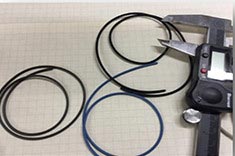EMI Shielding Products
- Custom Gasket Fabrication
- Connector Gaskets
- Bonded O Ring
- Custom Gaskets
- Conduct-O-Knit Knitted Wire Mesh
- Conduct-O-Seal Combo Gasket
- Conduct-O-Elastomer
- Conduct-O-Seal Oriented Wire in Silicone Gasket Material
- Conduct-O-Mesh Tape
- Conduct-O-Foam
- Conduct-O-Bond
- Optical Filters For Electronic Displays
- Shielded Vent Panels
- ESC Board Level Shielding
- 300 Series
Understanding Galvanic Corrosion
There are several causes of corrosion that concern EMI gaskets, but the one to be most concerned with is galvanic corrosion. This type of corrosion only happens when two metals that can generate a voltage are electrically joined by a current path while also being immersed in a fluid that can dissolve the less noble of the two metals. These conditions are present in batteries. Corrosion occurs when currents flow. The extent of corrosion is dependent upon the total current amount produced by a galvanic cell.

EMI Gaskets are placed in between two metal flanges. The first condition is readily satisfied because flanges are typically not made from the same metal as the gaskets. In fact, most flanges are made from steel or aluminum, whereas EMI gaskets more commonly contain silver, Monel, and tin. The second condition gets satisfied because of the inherent conductivity found within the EMI gasket. The last condition is realized after the electronic package is placed on the surface.
Engineers commonly use a Monel mesh or other money wire-filled materials. They are used because they are known as corrosion-resistant. They are the only materials that do not readily oxidize over time (even when moisture is present). Monel, at the same time, is highly active, meaning it has high electrochemical compatibility with aluminum flanges. It is challenging to find Monel on a galvanic table because it is not often used as a structural metal.
EMI Shielding
- EMI Shielding Management SolutionsEMI shielding is not impervious to EMI issues. Being aware of the most critical factors that affect both RFI and EMI shielding offer many management solutions. Utilizing different components is the most effective way to optimize shielding outcomes.
- Does Your Electronic Device Need RFI or EMI Shielding?
- The Importance of Gasket Junction Design



